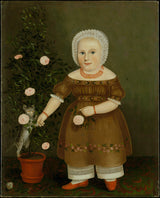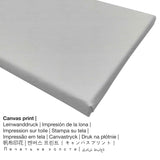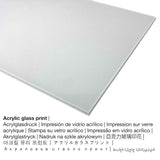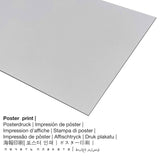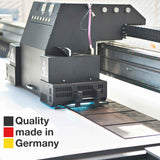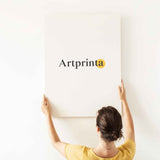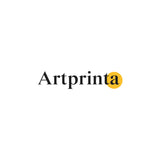John Bradley, 1844 - Emma Homan - mbipụta nka mara mma
Ụtụ gụnyere. Mbupu gbakọrọ na ndenye ọpụpụ.
Ihe gbasara nka nka karịrị afọ 170
N'elu 170 Onye na-ese ihe na-ese ọrụ nka afọ John Bradley. The artwork had the size: 34 x 27 1/8 in (86,4 x 68,9 cm). Mmanụ na kwaaji was used by the British painter as the medium of the masterpiece. Moveover, this work of art belongs to the art collection of The Metropolitan Museum of Art in New York City, New York, Njikota Obodo Amerika. Site n'ikike nke - Ụlọ ihe ngosi nka nke Metropolitan, New York, Onyinye Edgar William na Bernice Chrysler Garbisch, 1966 (ikikere: ngalaba ọha). : Onyinye nke Edgar William na Bernice Chrysler Garbisch, 1966. E wezụga nke ahụ, nhazi nke mmepụta dijitalụ bụ Eserese na a akụkụ ruru nke 1: 1.2, nke pụtara na ogologo bụ 20% mkpụmkpụ karịa obosara.
Nkọwa zuru oke site na webụsaịtị ihe ngosi nka (© Nwebiisinka - The Metropolitan Museum of Art - Museumlọ ihe ngosi nka nke Obodo)
Bradley may have emigrated from Ireland in 1826. By 1836 he had established himself as a portraitist in New York, where he attracted sitters eager for his marked attention to likeness and detail. For this portrait of two-year-old Emma Homan (1842–1908), Bradley posed her standing next to a potted rosebush and playing with her cat, which scales the plant and extends a paw to bat Emma’s finger.
Ozi nka ahaziri
| Aha nke ọrụ nka: | "Emma Homan" |
| nhazi ọkwa: | sere |
| Otu izugbe: | nkà nke oge a |
| Narị afọ nka: | 19th narị afọ |
| Afọ nka: | 1844 |
| Afọ nka: | karịa afọ 170 |
| Agba na: | mmanụ na kwaaji |
| Akụkụ izizi nka: | 34 x 27 1/8 na (86,4 x 68,9 cm) |
| Ụlọ ihe ngosi nka / mkpokọta: | Museumlọ ihe ngosi nka nke Obodo |
| Ebe ngosi nka: | New York City, New York, Njikota Obodo Amerika |
| URL webụ: | www.metmuseum.org |
| Ikikere nke ihe osise: | ngalaba ọha |
| Site n'aka: | Ụlọ ihe ngosi nka nke Metropolitan, New York, Onyinye Edgar William na Bernice Chrysler Garbisch, 1966 |
| kreditline ọrụ nka: | Onyinye nke Edgar William na Bernice Chrysler Garbisch, 1966 |
Tebụl nyocha nke onye na-ese ihe
| Aha onye nka: | John Bradley |
| Aha ndị ọzọ: | Bradley John I, John Bradley, John Bradley I, Bradley John |
| okike onye nka: | nwoke |
| Obodo onye nka: | British |
| Ọrụ nke onye na-ese ihe: | painter, printmaker, porcelain painter |
| Mba onye si: | United Kingdom |
| Nkewa onye nka: | omenkà nke oge a |
| Akwụsị: | 100 afọ |
| Afọ ọmụmụ: | 1790 |
| Afọ nwụrụ: | 1890 |
Họrọ ihe ị ga-ekwu
The product dropdown menu provides you with the chance to choose the material and size of your choice. Thus, we allow you to choose among the following options:
- Mbipụta aluminom (aluminium dibbond): An Aluminium Dibond print is a material with an outstanding depth. For our Print On Aluminum Dibond, we print your chosen artwork on the surface of the aluminum. The colors are vivid and luminous in the highest definition, fine details appear very clear, and the print has a a matte appearance that you can literally feel.
- Mbipụta kanvas: The canvas print is a printed cotton canvas mounted on a wood frame. How do I hang a canvas print on my wall? The advantage of canvas prints is that they are relatively low in weight. That means, it is easy and straightforward to hang the Canvas print without any wall-mounts. Because of thatcanvas prints are suitable for any kind of wall.
- Mpempe akwụkwọ ederede (akwa akwa akwa): The Artprinta poster print is a printed flat canvas paper with a fine surface finish. Please bear in mind, that depending on the size of the canvas poster print we add a white margin of approximately 2-6cm round about the painting in order to facilitate the framing with your custom frame.
- Mbipụta enyo acrylic: An acrylic glass print, which is sometimes described as a UV print on plexiglass, will convert your favorite artwork into beautiful wall décor and is a good alternative to aluminium or canvas fine art replicas. Your favorite artwork is printed with the help of state-of-the-art UV printing machines.
Banyere ihe
| Nkewa edemede: | ọmarịcha nka |
| Usoro mmeputakwa: | mmeputakwa n'ụdị dijitalụ |
| Usoro mmepụta: | UV kpọmkwem obibi |
| Mmalite ngwaahịa: | German mere |
| Stockdị ngwaahịa: | a na-achọ |
| Ngwaahịa were: | foto mgbidi, ihe ndozi ụlọ |
| Nhazi nka nka: | usoro eserese |
| Oke akụkụ: | 1: 1.2 ogologo ruo obosara |
| Nkọwa nha onyonyo: | ogologo bụ 20% mkpụmkpụ karịa obosara |
| Akụrụngwa dị: | Mpempe iko acrylic (nke nwere ezigbo mkpuchi iko), mbipụta ọla (aluminium dibond), mbipụta akwụkwọ mmado (akwụkwọ kwaaji), mbipụta kwaaji. |
| Nhọrọ nha nke akwa akwa n'elu etiti ihe na-agbatị (mbipụta kwaaji): | 50x60cm - 20x24", 100x120cm - 39x47", 150x180cm - 59x71" |
| Mbipụta iko acrylic (nwere ezigbo mkpuchi iko) nhọrọ nha: | 50x60cm - 20x24", 100x120cm - 39x47", 150x180cm - 59x71" |
| Mpempe akwụkwọ mmado (akwụkwọ kwaaji) nha: | 50x60cm - 20x24", 100x120cm - 39x47" |
| Nha ebipụta aluminium dibond: | 50x60cm - 20x24", 100x120cm - 39x47" |
| ụba: | na-enweghị etiti |
Nkwupụta iwu: We try our best to describe the art products as precisely as we can and to illustrate them visually in our shop. Nonetheless, the pigments of the printed materials, as well as the printing may vary slightly from the presentation on the device's screen. Depending on the screen settings and the nature of the surface, not all color pigments are printed as realisitcally as the digital version depicted here. Because the are printed and processed by hand, there may also be slight variations in the motif's size and exact position.
Edobere ederede a site na nwebisiinka © - Artprinta.com (Artprinta)

